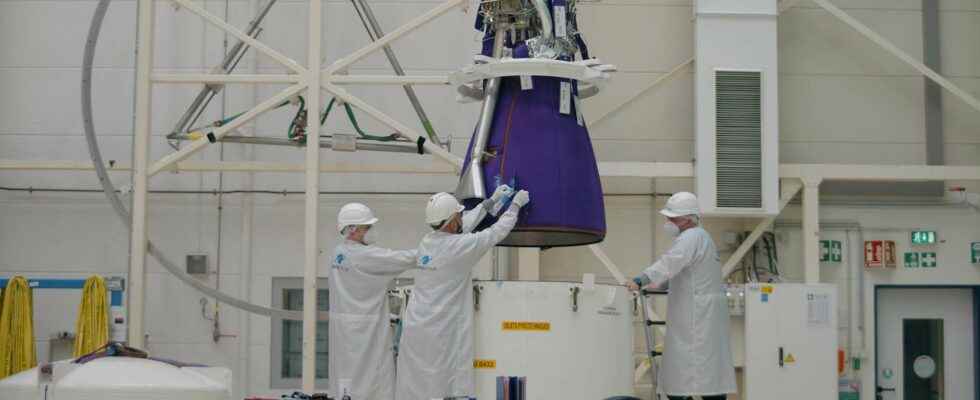The latest HM7 engine has been produced and has just passed its acceptance test at the ArianeGroup site in Vernon. This cryogenic engine may not mean anything to you, but for more than 43 years, it has guaranteed Europe autonomous access to space for its satellites. It has equipped all Arianes, from Ariane 1 to Ariane 5. With Ariane 6, it will give way to the reignitable Vinci engine. Olivier Condaminet, Liquid Propulsion Manager for Ariane upper stages, at ArianeGroup, reminds us of its peculiarities.
You will also be interested
[EN VIDÉO] The separation of the JWST from Ariane 5 This real-time video shows the separation of the James Webb Space Telescope from the Ariane 5 launch vehicle and the subsequent deployment of the solar arrays.
HM7. It’s the name of a cryogenic engine that perhaps means nothing to you. Although less known than viking of Ariane 4 and the Vulcans ofAriadne 5 and Ariane 6, HM7 nonetheless remains a historical and essential driver of the European space adventure. For more than 40 years, it has enabled Europe to have independent access to space for its satellites.
This propulsion engine hydrogen and oxygen liquids, whose technologies used date back to the 1960s, has equipped all the upper floors with pitchers of the Ariadne family. He flew on the first Ariane 1 on December 24, 1979 and will fly on the last Ariane 5, whose launch is scheduled for 2023. He will then have contributed 260 times to propelling Ariane, with his hundreds of passengers orbit around the Earth… and sometimes far beyond. At the Lagrange point 2 (Herschel, PlanckJames-webb) and even further with the missions Giotto and Rosetta for example.
of a mass of 165 kilogramsHM7 offers a thrust in vacuum of some 7 tons as well as a specific impulse of 446s.
Tomorrow, it will be replaced by the re-ignitable Vinci engine on Ariadne 6 thus offering a greater versatility of missions required by the new needs of the customers ofArianespace. A few days ago, the latest Ariane 5 HM7 engine passed its acceptance test at the ArianeGroup site in Vernon. The PF41 test bench, on which it has been tested for more than 40 years, will now contribute to writing a new page in the aerospace adventure: the green hydrogen revolution.
This is an opportunity for us to introduce you to this little-known engine. The word to Olivier Condaminet, Propulsion Manager Liquid Ariane upper floors, at ArianeGroup.
Futura: What were the significant innovations or technological advances on this engine when it entered service in 1979?
Olivier Condaminet: When the HM7 engine entered service, it was the first cryogenic engine used in Europe. It represents real technological advances concerning the control of extreme temperatures, very cold as well as very hot for the components.
From which engine is the HM7 the heir?
Olivier Condaminet: HM7 is based on the experience acquired during the development of the HM4 engine, a prototype engine of 4 tons of thrust equipped with a turbo pump feeding 4 combustion chambers in liquid hydrogen and oxygen, and which has never flown.
If any, what legacies will the HM7 engine leave?
Olivier Condaminet: All cryogenic engines developed at Vernon are part of the HM7 heritage in matter design, development and implementation. We therefore include the series of Vulcain engines (Vulcain, Vulcain 2 and Vulcain 2.1), the Vinci which will equip the upper stage of Ariane 6 and Prometheuswhich will work with an oxygen-methane mixture, is a demonstrator reusable engine at very low cost, the objective of which is to be ten times less expensive than the current Vulcain 2 engine of Ariane 5.
Does HM7 have a special feature that makes it unique, for example, perfectly suited to Ariane 5?
Olivier Condaminet: From the H8 stage of Ariane 1 to the Esca stage of Ariane 5, the HM7 engine powered the upper stages of Ariane for more than 40 years. It is the upper stage engine par excellence, particularly suitable for all missions targeting geostationary orbit.
Year after year, Ariane 5’s performance has never stopped improving. From almost 6 tons for the first Ariane 5 (Ar 5G), the performance has risen to more than 10 tons for the Ariane 5 ECA, including a record flight with more than 11 tons of payload (VA 255, 11,210 kilos ). To what extent has HM7 contributed to this continuous improvement in the performance of Ariane 5?
Olivier Condaminet: These are essentially the boosters and the Vulcain engine which provide the main thrust and contribute to the performance in terms of payload mass. The evolutions of these engines have contributed to the increase in Ariane’s capacity, in particular the transition from the Vulcain version to the Vulcain 2.
HM7 will be replaced by the restartable Vinci engine for the upper stage of Ariane 6. Is it replaced “only” because Vinci can be restarted several times in flight or because its technology, which dates back to the 1960s, has his time ?
Olivier Condaminet: Beyond the relighting, which is the major argument, we can mention the increase in thrust (from 7 tons to 18 tons) and the industrial optimization of its production.
If HM7 and Vinci are and will be the guarantors of European autonomy in access to space, Vinci must also do so at a reasonable cost, which was not necessarily a priority when it came to acquiring this autonomy in the early 80s. Was the cost of manufacturing and using HM7 also a factor pushing towards its withdrawal?
Olivier Condaminet: The Vinci is indeed optimized in this sense.
Interested in what you just read?
